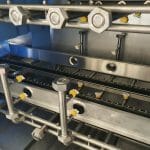~ Why some experts believe automated delivery vehicles might be realised sooner than you think ~
In the US sci-fi sitcom Futurama, the protagonist Fry is blasted forward in time to New Year 2999 where he finds he is still, alas, a humble pizza delivery boy. Recent trends suggest, however, that many deliveries will soon be fulfilled by automated technologies, whether that is automated trucks, drones or robots. Here, Roger Brereton, head of sales at steering systems specialist Pailton Engineering, looks at why some experts are expecting a greater role for automation in deliveries sooner than you might think.
The effort to automate vehicles began with passenger vehicles. Now, there is arguably greater focus on automating deliveries. Around the world, many companies and governments are trialling drones, robots and autonomous trucking to help meet growing demand.
The rise of e-commerce, coupled with growing consumer preferences for same-day or next-day delivery, is one factor that is driving this interest, as those in transportation and logistics seek ways to provide cheaper and more efficient deliveries. According to a recent report from UNCTAD, 2020 will come to be seen as a major turning point in the rise of e-commerce, which grew as a percentage of total retail trade from 14 percent to 17 percent globally.
Another structural factor that shouldn’t be overlooked is the importance of urbanisation. Ask any specialist in logistics and they will tell you that the final mile of delivery is the most difficult. According to some estimates, last mile delivery accounts for over half the cost of delivery. Dense and complex urban environments, which include high rise buildings, limited parking spaces and unusual traffic regulations, add to the difficulties of last mile delivery.
According to UN estimates, the percentage of all people living in urban areas is expected to rise from its current level of 55 percent to 68 percent by mid-century. Those in the logistics industry have every incentive therefore to investigate the possibility of automated vans, robots or drones as a solution to this growing dilemma.
For autonomous delivery trucks and vans, automation might provide an answer to worker shortages. In the US for example, driver shortage is estimated to reach 150,000 by 2028. The long hours and difficult working conditions make it expensive and difficult to recruit enough drivers, in an industry where turnover is high.
Although fully autonomous vehicles are a long way off, greater automation, such as platooning, is seen as a potential means of improving productivity to meet the extra demand that these vehicles will face. This involves linking two or more trucks together using connectivity and automated driving support systems. As early as 2016 a convoy of self-driving trucks arrived in the Dutch port of Rotterdam, having travelled all the way from Sweden.
While technologies like LiDAR and 5G connectivity open the door to this revolution in transport, other areas of engineering must keep pace. From suspension joints to column design, parts suppliers must be able to offer design flexibility and high-quality vehicle components to help original equipment manufacturers (OEMs) develop automated vehicles.
If all of the above sounds somewhat speculative, it is worth noting the number of trials that are already taking place and the fact that governments are relaxing regulations to encourage this. The US Department of Transportation has granted an exemption to normal rules to allow Nuro to test R2, its autonomous van, in Texas. In the UK, the Academy of Robotics is trialling its Kar-go to carry out deliveries from pharmacies to care homes on the streets of Hounslow.
We cannot say with certainty when fully automated vehicles and robots will take over the job of fulfilling our increasing demand for deliveries. It seems likely, however, that this revolution will take place before the year 3000. Contra Futurama, Fry might find he has been replaced by a drone or automated van. After all, Nuro’s R2 has already announced it will be delivering Pizza for Domino’s.








